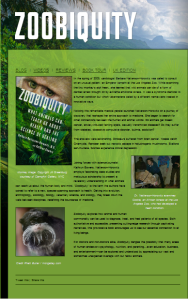Zoobiquity: a review
Books & Videos: The Books & Videos category of the CETFA blog aims at presenting and discussing books and videos that can contribute to a good understanding of farm animals, animal agriculture and related welfare issues, or more generally of animals’ intelligence and sentience.
In this post, Dr. Dana Medoro, English professor at the University of Manitoba, and board member of the Winnipeg Humane Society, reviews for us the book Zoobiquity, with an emphasis on the sections related to farm animals.

“I can’t say enough about Zoobiquity: it’s a fun read, and it’s so obviously entrenched in a compassionate understanding of other animals. The authors constantly remind us that their knowledge and data is NOT gleaned from laboratory animals but from animals who were observed in their own habitats.
When they do discuss zoo animals, you can tell that they’re uncomfortable, going to great lengths to discuss advancements in the understanding of confined zoo animals. In fact, they demonstrate that fat and depressed zoo animals are worth studying because the zoos need to do better by them (if they’re going to trap animals at all). The studies of zoo animals being fed the kind of diets they’d eat in the wild –instead of lumps of dog food– reveal the correlation between mood and the expression of natural behaviors.
The whole book is about how other animals feel emotions just as we do; that pain, excitement, calmness, depression are commonly felt across the so-called species barrier and that charges of “anthropomorphism” are misguided and basically wrong in most cases. In some cases, anthropomorphism needs to be taken under consideration. There are species-specific experiences outside human frameworks of interaction, for example.
The authors seem really to enjoy all the quirks of other animals, and when they do assert comparisons between other animals and human animals, they do so in the name of healing psychological and physiological ailments. For example, humans aren’t the only species that gets addicted to substances; some dogs really like to lick cane toads in order to get high. Trying to understand why many members of the animal kingdom become caught up in addictive compulsions is one of the goals of the book. Their aim is to help both humans and other animals achieve mental and physical health.
There isn’t a lot in the book about farm animals, but when they do arise, the excerpts are excellent. In their chapter on fear in animals, they assert, “[Our] examples come from animals in the wild, but stress before being slaughtered in broiler hens, sows, steers, and lambs damages their muscles, too. The same muscles, when wrapped in plastic on a Styrofoam tray, are sold as meat. Some farmers recognize this and (perhaps for the wrong reasons) strive toward less-stressful slaughter techniques” (page 118). The bracketed statement, “perhaps for the wrong reasons,” is very interesting: i.e. the wrong reasons include reducing stress for tastier meat; the right reasons would include caring about the fact that the animals feel such intense stress.
Later on, in their chapter on fatness in animals, they begin by discussing the necessity of understanding digestion in humans and other animals and how bacterial life inside our intestines matter to fat absorption. Then, part way through the chapter, they say this: “I’d [this is the cardiac surgeon writing] long known that antibiotics are used in farming to stop the spread of certain diseases, especially under cramped and stressful living conditions. But antibiotics don’t just kill the bugs that make animals sick. They also decimate beneficial gut flora. And these drugs are routinely administered even when infection is not a concern. The reason may surprise you. Simply by giving antibiotics, farmers can fatten their animals using less feed” (page 151).
Again, the typography is telling: the italics draw attention to the economic bottom line of factory farms, the ridiculous exchange of antibiotics for food. The italicized section also indicates that antibiotic use is potentially fattening in humans too, given that pigs and chickens have “gastrointestinal tracts similar to ours” (151). Here, the similarity isn’t just used to help humans understand why they get fat but also to insert a surprising mirror between humans and pigs and chickens. If our digestive systems are so much alike, then how else are we like these animals that we permit to be stuffed into battery cages and gestation crates?”
For more information:
Zoobiquity: What Animals Can Teach Us About Health and the Science of Healing. Barbara Natterson-Horowitz & Kathryn Bowers, Knopf, 320 pages (2012).
http://zoobiquity.com/book


